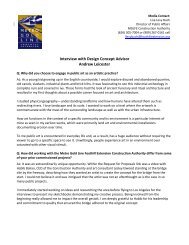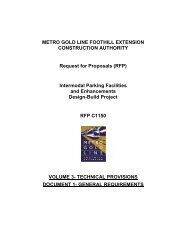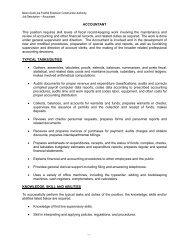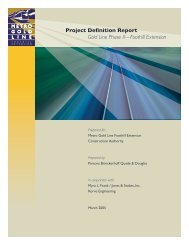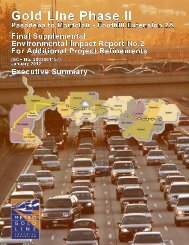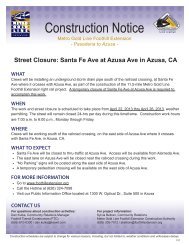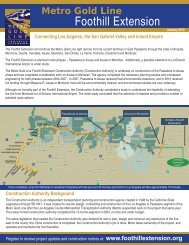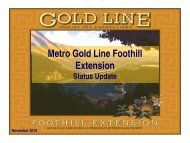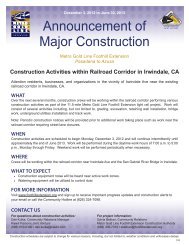Part 3 - Metro Gold Line Foothill Extension
Part 3 - Metro Gold Line Foothill Extension
Part 3 - Metro Gold Line Foothill Extension
You also want an ePaper? Increase the reach of your titles
YUMPU automatically turns print PDFs into web optimized ePapers that Google loves.
Noise and Vibration Technical Report: <strong>Metro</strong> <strong>Gold</strong> <strong>Line</strong> <strong>Foothill</strong> <strong>Extension</strong>, Azusa to Montclair<br />
July 2012<br />
Page 85<br />
• Ballast Mats – A ballast mat consists of a pad made of rubber or rubber-like material placed on the<br />
subballast with normal ballast, ties, and rail on top. The reduction in groundborne vibration provided<br />
by a ballast mat is strongly dependent on the frequency content of the vibration and the design and<br />
support of the mat. Depending on the soil properties, an asphalt or concrete layer under the ballast<br />
may be required.<br />
• Tire Derived Aggregate (TDA) – TDA consists of a resilient layer of shredded tires or recycled<br />
rubber chips placed beneath the sub-ballast layer of standard open ballast and tie track. This<br />
mitigation method provides results similar to ballast mats and would be strongly dependent on the<br />
frequency content of the vibration. This is a relatively new vibration mitigation approach that has<br />
been successfully implemented by Denver Regional Transit and the Santa Clara Valley<br />
Transportation Authority. In both Santa Clara Valley and Denver, 12-inch layers of TDA were<br />
installed.<br />
• Relocation of Crossovers or Special Trackwork – The special trackwork at crossover locations<br />
increase vibration by about 10 dB. Relocating crossovers away from residential areas will help to<br />
eliminate impacts. If crossovers cannot be relocated away from residential areas, another approach is<br />
to use specially designed ‘low-impact’ frogs in place of standard rigid frogs. Examples of low-impact<br />
frogs include flange-bearing, spring-rail, and moveable point frogs.<br />
• Floating-Slab Track – The track is constructed on a concrete slab that is supported by resilient<br />
elements (either pads 8 to 12 inches thick or a continuous resilient mat). This type of track<br />
construction is very expensive and is typically used only where substantial vibration mitigation is<br />
needed.<br />
Mitigation is considered for all clusters that exceed the vibration threshold for light-rail operations. Table<br />
37 presents the recommended vibration mitigation locations, types, and lengths for the Azusa to Montclair<br />
corridor. The majority of the vibration mitigation is in Glendora (15,900 feet). The residences along<br />
Lemon Avenue in Glendora (between Pasadena Avenue and the Dalton Wash) are located close to the<br />
LRT tracks (within 50 feet), and the estimated attenuation from TDA or ballast mat is insufficient to<br />
reduce the predicted vibration to below the FTA impact thresholds. Floating slab track is capable of<br />
providing the necessary attenuation.<br />
City<br />
Table 37: Recommended Locations for Vibration Mitigation<br />
Eng. Station Length<br />
Start End<br />
(ft)<br />
Mitigation Type<br />
Clusters Mitigated<br />
Glendora 1430+50 1464+00 3,350 Ballast Mat/TDA EB 1-5<br />
Glendora 1468+00 1482+00 1,400 Ballast Mat/TDA EB 5a<br />
Glendora 1492+50 1495+50 200 Ballast Mat/TDA WB 2<br />
Glendora 1518+00 1579+00 6,100 Floating Slab WB 4-15, EB 7<br />
Glendora 1583+00 1601+00 1,800 Ballast Mat/TDA WB 16-18, EB 9<br />
Glendora 1604+00 1632+00 2,800 Ballast Mat/TDA WB 19-20, EB 10-11<br />
Glendora 1663+00 1665+50 250 Ballast Mat/TDA EB 12<br />
Total Length Glendora (ft) 15,900<br />
San Dimas 1667+00 1670+00 300 Ballast Mat/TDA WB 1



